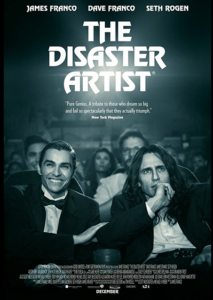
 If Tommy Wiseau is in real life anything like his depiction in “The Disaster Artist,” he has no business being around a movie set. There is a terribly uncomfortable scene in this film that should act as a cautionary tale for any prospective filmmaker. Tommy (played in eerie parody by James Franco) appears on set nude with a bag of some sort covering his genitals. What he does next is horrifying.
If Tommy Wiseau is in real life anything like his depiction in “The Disaster Artist,” he has no business being around a movie set. There is a terribly uncomfortable scene in this film that should act as a cautionary tale for any prospective filmmaker. Tommy (played in eerie parody by James Franco) appears on set nude with a bag of some sort covering his genitals. What he does next is horrifying.
Fans of the 2003 feature “The Room” will probably see “The Disaster Artist” as an extension of the running joke that has propelled the awful source material to cult infamy all over the world. “The Room” is a bad movie on every level. Having attended a midnight screening of the film filled with rabid fans, I can attest that it is a subversive crowd-pleaser. But what are the viewers celebrating?
Thankfully, I don’t think that Franco’s take on the story of the creation of this cinematic anti-triumph paints the central protagonist, Wiseau, in a favorable light. Weird is one way to describe him. Creepy is another. One character in the film says that he is kind of like a vampire. And the only reason that people take him seriously is that he has money—lots of it. The source of his funds remain a mystery, which understandably makes everyone uncomfortable. But that worry does not keep them from taking his ready supply of checks. And frankly, I wonder if money-laundering could have been a motivation.
In “The Disaster Artist,” we meet Tommy (Franco’s impersonation) when he’s taking acting lessons. He distinguishes himself as a spectacularly bad actor, but after going way over-the-top in a class exercise, he impresses insecure, fellow student Greg (Dave Franco). A struggling actor with limited talent, Greg sees Tommy as an opportunity to get him notice. Maybe it is a sick fascination or just naivety, but Greg soon moves in with Tommy and the two take off to Los Angeles. And after failing to find acting work, they hatch an idea to make their own damn movie. In glamorized, romantic fashion, Tommy writes it on an old type-writer.
This isn’t your typical Hollywood success story. And it certainly shouldn’t act as a template for how to make it in show business. While there is no hint of this, it is impossible not to get a kind of “Producers” vibe as Tommy and Greg carry out their flawed plan. Again, I couldn’t shake the thought that money-laundering could have been involved. The extremely odd and impossible to read Wiseau clearly believes in his material, and in writing, directing and staring in “The Room,” he is intent on making a serious drama. We all know that is not what happened, and he unintentionally gave birth to what many say is the worst movie ever made.
The Franco brothers are very good here. While much attention will be paid to James, who does a little of everything on the production, little brother Dave helps ground the narrative by playing the voice of reason, the straight man to James’ tweaked, and heavily masked performance. Through the use of prosthetics, James Franco looks very much like Wiseau. And he manages to capture the same vocal range and mannerisms in an uncanny way.
But it is still an impersonation. When, in a final end credit tag, we see them both on screen together, I recognized that as good as James is in the role, it was a character too alien to ever engender any kind of authentic viewer connection. And I think this is where the film fails. We see the events through Greg’s eyes, but he’s such a milquetoast personality that he too is hard to bond with.
The mystery surrounding the Wiseau restricts James to only known aspects of the personality even though Wiseau is still very much available to study. I suppose that James couldn’t get below the well-known Wiseau facade. This means that “The Disaster Artist” reveals little new information about the man behind “The Room.” Instead, we only see a dramatization of much of what we’ve already seen in midnight screenings.
The script is from Scott Neustadter and Michael H. Weber, who adapt the book by the real Greg Sestero and Tom Bissell. And in order to bring the film to a close, the writers engage in a bit of a cheat or, at best, a significant amount of time compression. Success for “The Room,” as I understand it, was not immediate, and at the initial premiere, many viewers left early into the screening. To me, this cheapens the entire narrative.
“The Disaster Artist” is shot flatly with a look approximating a television docudrama. Cinematographer Brandon Trost (“The Interview” and “This is the End”) has adopted a visual style similar to that employed in the satirical features of Christopher Guest (See “Best in Show” and “A Mighty Wind”). But where Guest was able to make us care about his wacky, exaggerated characters mainly by revealing something of their motivations, Franco is hamstrung by only revealing the Wiseau that many of us already know. One wonders what may have happened had the production employed a more whimsical approach (like that often taken by Charlie Kaufman) in order to suggest some answers to all the nagging questions.
What’s left is gags and intentional humor based on unintentional laughs from the source material. Instead of being consistently funny, much of the film is downright cringeworthy. As a cautionary tale, “The Disaster Artist” succeeds, but as a comedy, it’s more disturbing and subversive than a laugh riot.

it’s getting good reviews but I know 4 people who just saw it and came back and told me it was the worst movie they have seen in years. Maybe if you have seen Room you would get the jokes…I will wait til dvd
It certainly works for Room devotees. It certainly isn’t a terrible movie, but a miss, in my opinion. Maybe I can get our other critics to weigh in here. One thing is for sure, the SXSW crowd was very high on the film.